
INTRODUCTION
the 8048's instruction set and incorporates
several new features critical in low cost
applications.
Even with low component costs, however, a
project may
be
jeopardized by high develop-
ment and rework costs resulting from
an
inflexible production design. Intel has solved
this problem by creating two pin-compatible
versions
of
the 8048
microcomputer:
the
8048 with mask Programmable ROM pro-
gram memory for low cost production and
the
8748
with user programmable and
erasable EPROM program memory for
prototype
development. The 8748
is
essen-
tially a single chip microcomputer "bread-
board" which can
be
modified over and over
again during development and pre-produc-
tion
then replaced by the low cost
8021
*,
8048,
or
8049 ROM
for
volume production.
The
8748 provides a very easy transition
from
development to
production
and also
provides
an
easy vehicle
for
temporary field
updates while new ROMs are being made.
SPECIAL FEATURES
• SINGLE
5V
SUPPLY
• 40 PIN
DIP
OR 28 PIN
DIP
• PIN COMPATIBLE
ROM
AND EPROM
•
2.5,5.0
AND
10.0
J,Lsec
CYCLE
VERSIONS
•
ALL INSTRUCTIONS 1
OR
2 CYCLES
• SINGLE STEP
•
8 LEVEL STACK
•
2 WORKING REGISTER BANKS
•
LC, XTAL, OR
EXTERNAL
FREQUENCY
SOURCE
•
OPTIONAL
CLOCK
OUTPUT
• POWER
DOWN
STANDBY
MODE
To
allow the MCS-48
to
solve a wide range
of
problems and to provide
for
future
expansion,
all 8048 and 8049
functions
have been made externally expandable
using either special expanders
or
standard
memories and
peripherals. An
efficient
low
cost means
of
I/O
expansion is provided by
either the 8243
I/O
Expander
or
standard
TTL
or
CMOS circuits. The 8243 provides
16 1/0 lines in a
24
pin package. For sys-
tems with large 1/0 requirements, multiple
8243s can be used.
For such
applications
as
Keyboards, Dis-
plays, Serial communication
lin~s,
etc.
standard
MCS-80/85 peripheral
circuits
may be added. Program and data
memory
may be expanded using standard memories
or
the 8355 and 8155 memories
that
also
include programmable
I/O
lines and
timing
functions.
For
applications
which require a more
custom
tailored interface, the
8041
or
8741
Universal Peripheral Interface (UPI-41)
devices can be used. The UPI-41 devices
are
available in both ROM and EPROM
versions and are essentially slave versions
of
the 8048/8748 which are designed
to
interface
directly
with expandable MCS-48
processors and provide flexible
intelligent
I/O
capability. The 8041/8741 share the
instruction set
of
the MCS-48 family
of
processors.
The
8035
and
8039 are an 8048
or
8049
respectively
without
internal
program
memory
that
allows
the
user
to
match
his
program
memory
requirements
exactly
by
using
a
wide
variety
of
external
memories.
The
8035 and 8039
allow
the
user
to
select
a
minimum
cost
system
no
matter
what
his
program
memory
reo
quirements.
The
8035L is an 8035
with
the
powerdown
mode
of
the
8048.
The MCS-48 processors are designed to be
efficient
control
processors
as
well
as
arithmetic processors. They provide
an
instruction set which allows the user
to
directly
set and reset individual lines
within
its 1/0 ports
as
well
as
test individual bits
within the
accumulator. A large variety
of
branch and table
look-up
instructions
l11ake
these processors very efficient in
implementing standard logic functions.
Also, special attention has been given to
code efficiency.
Over
70%
of
the
instruc-
tions are a single byte long and all others
are
only
two
bytes long. This means many
functions requiring 1.5K
to
2.0K bytes in
other
computers
may very well be
com-
pressed into the 1 K words resident in the
8048
or
up
to
3K to 4K equivalent bytes may
be compressed into the
8049.
*The
8021
is
code
compatible
but not pin
compatible
with the 8748.
1·2


















